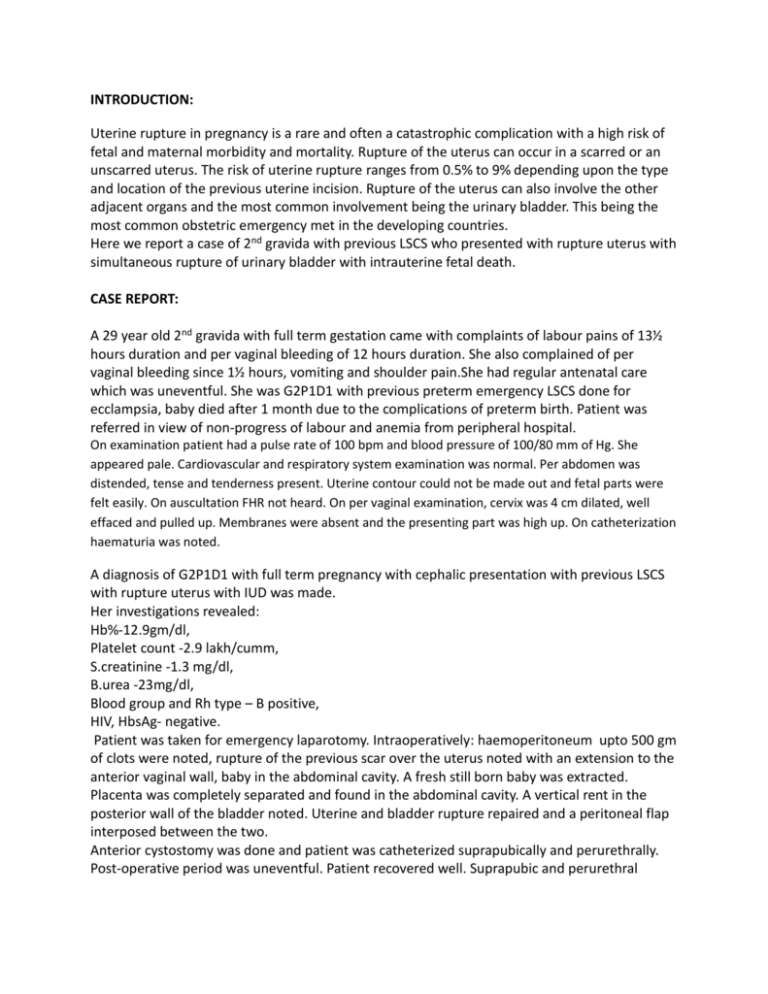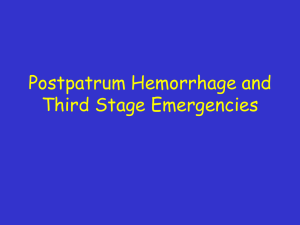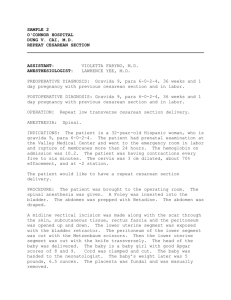INTRODUCTION: Uterine rupture in pregnancy is a rare and often a
advertisement

INTRODUCTION: Uterine rupture in pregnancy is a rare and often a catastrophic complication with a high risk of fetal and maternal morbidity and mortality. Rupture of the uterus can occur in a scarred or an unscarred uterus. The risk of uterine rupture ranges from 0.5% to 9% depending upon the type and location of the previous uterine incision. Rupture of the uterus can also involve the other adjacent organs and the most common involvement being the urinary bladder. This being the most common obstetric emergency met in the developing countries. Here we report a case of 2nd gravida with previous LSCS who presented with rupture uterus with simultaneous rupture of urinary bladder with intrauterine fetal death. CASE REPORT: A 29 year old 2nd gravida with full term gestation came with complaints of labour pains of 13½ hours duration and per vaginal bleeding of 12 hours duration. She also complained of per vaginal bleeding since 1½ hours, vomiting and shoulder pain.She had regular antenatal care which was uneventful. She was G2P1D1 with previous preterm emergency LSCS done for ecclampsia, baby died after 1 month due to the complications of preterm birth. Patient was referred in view of non-progress of labour and anemia from peripheral hospital. On examination patient had a pulse rate of 100 bpm and blood pressure of 100/80 mm of Hg. She appeared pale. Cardiovascular and respiratory system examination was normal. Per abdomen was distended, tense and tenderness present. Uterine contour could not be made out and fetal parts were felt easily. On auscultation FHR not heard. On per vaginal examination, cervix was 4 cm dilated, well effaced and pulled up. Membranes were absent and the presenting part was high up. On catheterization haematuria was noted. A diagnosis of G2P1D1 with full term pregnancy with cephalic presentation with previous LSCS with rupture uterus with IUD was made. Her investigations revealed: Hb%-12.9gm/dl, Platelet count -2.9 lakh/cumm, S.creatinine -1.3 mg/dl, B.urea -23mg/dl, Blood group and Rh type – B positive, HIV, HbsAg- negative. Patient was taken for emergency laparotomy. Intraoperatively: haemoperitoneum upto 500 gm of clots were noted, rupture of the previous scar over the uterus noted with an extension to the anterior vaginal wall, baby in the abdominal cavity. A fresh still born baby was extracted. Placenta was completely separated and found in the abdominal cavity. A vertical rent in the posterior wall of the bladder noted. Uterine and bladder rupture repaired and a peritoneal flap interposed between the two. Anterior cystostomy was done and patient was catheterized suprapubically and perurethrally. Post-operative period was uneventful. Patient recovered well. Suprapubic and perurethral catheter were removed on 18th and 21st post-operative day respectively. Patient was discharged on 23rd post-operative day. DISCUSSION: The clinical presentations of concomitant uterine and bladder rupture at the time of VBAC are variable and depend on the time, location and type of uterine rupture that extends onto the adjacent organs. Severe signs and symptoms can result when a complete rupture occurs intrapartum, including a non-reassuring fetal heart tracing1,2 , loss of the presenting part on pelvic examination, change in uterine shape, cessation of uterine contractions, abdominal pain, vaginal bleeding, and even maternal shock3,4. Gross hematuria is the most common sign of uterine rupture associated with bladder rupture. Other rare presentations such as vernixuria, meconium stained urine, urinary incontinence induced by vesicouterine fistulas, fever, and urinary tract infections have also been noted5-8. The signs and symptoms directly correlate with the time of bladder rupture. The diagnosis requires a high degree of suspicion and awareness. Various risk factors in relation to uterine rupture during a trial of labor have been identified, including a classic uterine incision, induction with prostaglandins, single-layer closure of a prior uterine incision, an interpregnancy interval <18 months, and a prior preterm cesarean delivery9. The major hypothesis for uterine rupture related to a prior preterm cesarean delivery is poor wound healing in an undeveloped lower segment of the uterus. Even if the incision is transverse, it would likely encounter the same problems with adequate healing as a classical incision. In our patient the rupture occurred intrapartum as she had the following risk factors Previous pre term LSCS Interpregnancy interval of 18 months (1½ years) Prolonged trial of labour Figure 1: Baby freely floating in the abdominal cavity Figure 2: Foley’s bulb visualized through a rent in the posterior wall of the bladder and site of rupture of the scar Figure 3: Repaired uterine rupture and bladder rupture with foley’s through the anterior wall of the bladder. CONCLUSION: The high maternal morbidity, maternal mortality and fetal mortality that follow uterine rupture calls for an integrated effort to prevent its causes. Good ANC, Family planningservices, prompt referral of obstructed labor, availability of transportation and obstetric care are the essential factors to prevent uterine rupture and to decrease the maternal mortality, fetal mortality and maternal morbidity associated with it REFERENCES: 1. Quilligan EJ. Vaginal birth after cesarean section: 270 degrees. J Obstet Gynaecol Res 2001; 27: 169–73. 2. Rageth JC, Juzi C, Grossenbacher H. Delivery after previous cesarean: a risk evaluation. Obstet Gynecol 1999; 93: 332–7. 3. McMahon MJ. Vaginal birth after cesarean. Clin Obstet Gynecol 1998;41:369–81. 4. Yap OWS, Kim ES, Laros RK. Maternal and neonatal outcomes after uterine rupture in labor. Am J Obstet Gynecol 2001; 184: 1576–81. 5. Kattan SA. Maternal urological injuries associated with vaginal deliveries: change of pattern. Int Urol Nephrol 1997; 29: 155–61. 6. Popli K, Puri M, Gupta A. Cord prolapse though the urethra. Aust N Z J Obstet Gynaecol 2002; 42: 413. 7. O’Grady JP, Prefontaine M, Hoffman DE. Vernixuria: another sign of uterine rupture.J Perinatol 2003; 23: 351–2. 8. Gupta A, Chauhan M, Dahiya P, Sangwan K. Meconium stained urine: an unusual sign of combined uterine and bladder rupture. Aust N Z J Obstet Gynaecol 2005; 45: 334. 9. Smith JG, Mertz HL, Merrill DC. Identifying risk factors for uterine rupture. Clin Perinatol 2008; 35: 85–99. 10. Bergeron ME, Jastrow N, Brassard N, Paris G, Bujold E. Sonography of lower uterine segment thickness and prediction of uterine rupture. Obstet Gynecol 2009; 113: 520–2.











